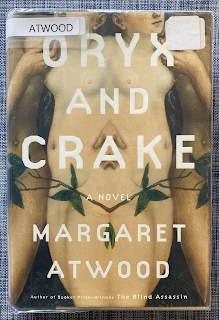Binti, The Complete Trilogy -- Nnedi Okorafor
In Binti, Okorafor tells the story of the titular character, a young Himba woman on Earth, roughly 700 years in the future. Binti is the first Himba person to gain admission to the prestigious Oomza University, an entire planet dedicated to learning and teaching. This fish-out-of-water setting enables fun worldbuilding almost like a sci-fi Harry Potter book. For example, on Earth, the Himba live near the Khoush people, who are well-represented humans at Oomza, and are engaged in a perpetual war with the Meduse, a species of floating jellyfish-like beings. En route from Earth to Oomza (in a very cool shrimplike sentient spaceship), Binti and her Khoush classmates are attacked by the Meduse, setting up the remainder of the series: Binti reckoning with, and mediating between, a variety of clashing cultures.
Overall, this is an entertaining read. There are some points that I found odd or frustrating, but these are surely outweighed by the story's strengths.
The main frustration to me is the depiction of Binti as an expert mathematician and engineer. It is absolutely critical that we increase the representation of people of color and women as mathematicians in fiction, because doing so has the incredible power to inspire people who are most likely to be discouraged by systemic, cultural barricades. In Binti, however, mathematics is written basically like an innate magical ability, inexplicably requiring an ability to call up a "current" by performing "treeing." Currents then somehow enable Binti to build and manipulate small mechanical objects. Treeing is never clearly explained, but comes across as a type of meditation wherein one takes a simple equation and then creates "branches" of increasing complexity (maybe by adding new operations?), which struck me as random and unnecessary. By contrast, consider Gaal Dornick in the new Foundation Apple TV series. She is incredibly similar to Binti in her backstory and latent mathematical ability, but she works really hard to become good at math despite her home culture treating it as heresy. This depicts both the capacity of young Black women to become expert mathematicians, and the systemic discouragement they may face. In any case, I really appreciated that Binti is portrayed as a mathematician and engineer; I just wish the math, and the process of becoming a mathematician, had been portrayed more as a skill than a talent.
Something that is not quite a weakness or a strength is how tiny the book's universe feels. I think that Okorafor has scoped the book quite well. There are no grand claims of saving the universe or even an entire planet, but really just one small village. Similarly, the conflict between the Khoush and Medusae is local in that it doesn't seem to afflict any other major human groups. But, we never even learn if there are other humans besides those living near and around the Khoush in what is roughly modern-day Namibia. The structure of the book (as three tiny novellas plus a short story) means that any worldbuilding is a bit rushed or dense so that the author can focus on the core story. I would have enjoyed it going a bit more slowly.
The main strength of Binti is, to me, its depiction of trauma. After Binti's ordeal where she and her classmates are attacked by the Meduse in space, she continually has flashbacks and panic attacks, often leaving her confused or incapacitated. This happens randomly, but also with particular triggers (seeing Meduse reveal their stingers, for example). It is an incredibly faithful representation of a character learning to handle and work with trauma and mental health challenges, as opposed to ever being miraculously healed.
The second strength of the series is Binti's depiction as a cultural mediator. As the story progresses, she picks up or is assimilated by five or six totally different groups of people (human or non-human), and must process the conflicting cultures both within herself and between the people she deals with. This delightfully reminded me of the cultural translators of a far-future Atlanta in Diaspora by Greg Egan, and of the real-life cultural translation role played by administrators at the University of Michigan as depicted in Equity in Science by Julie Posselt. In the latter work, cultural translators actively make graduate science education significantly more accessible to people from underprivileged backgrounds, indicating the critical importance of discussion across cultural boundaries in our society. The key difference in Binti is that we watch the character take on and learn each culture, serving as a perfect analogy for the difficulty and reward that come with this most important social role.
The final strength I want to affirm is the sheer creativity of worldbuilding, especially the giant shrimplike sentient spaceships and the wide variety of non-human beings. Most notably, the story contains a plethora of weird, fun biotechnology, much like in The Big Aha or The Highest Frontier; for both of those books, the biotech was basically the only part I liked, so I deeply enjoyed that Binti wrapped neat technology in an exciting and powerful plot.
Altogether, I enjoyed Binti, and would suggest giving it a quick read.


Comments
Post a Comment